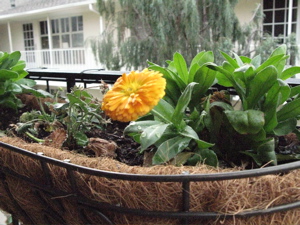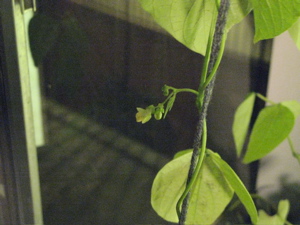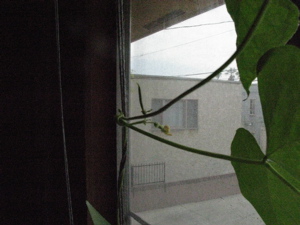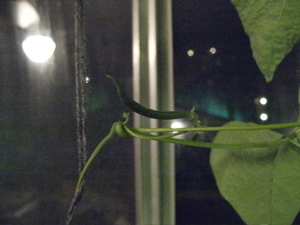In Permaculture lingo, “stacking functions” refers to building redundancies into a sustainable garden. In a forest, a tree doesn’t just do one thing; instead, it performs multiple jobs, like regulating climate, sequestering carbon, holding soil together, providing habitat, and giving food, just to name a few. One of the problems with industrialized society is that almost every aspect of our lives is specialized – there are shockingly few things we do or have that that perform more than one or two functions. This is especially true in our food and habitat (for most of us, houses and apartments), and it leads to an incredible amount of waste. Imagine if forests needed a separate organism to do each and every single job that one tree can easily perform.
Take, for example, a lawn. The lawn is pretty much the epitome of wasted space. Most of the time, it performs one single function: looking nice (if you like the way lawns look, something I personally can’t wrap my head around). Sometimes – sometimes – it also serves as a recreational area, so that’s two functions, which wouldn’t be so bad if lawn wasn’t the single largest crop in the United States. If you add a hedge to the edge of it to make it look nicer, you again have a plant that probably only serves one function – and notice that they don’t help each other out very much. If you find it impossible to keep your lawn healthy, this wasted space and lack of relationships is the reason why. Lawn is a monoculture, and there’s a reason monocultures never occur in nature.
To build a truly ecological garden, you need to make sure that all your plants are performing multiple tasks (and that all tasks are being done by multiple plants – more on that in a minute). For example, if you’re a fan of flowers, don’t just get a variety that looks nice. Try to find a flowering vegetable or perennial herb, or a creeping vine that acts as mulch or shades a window, or an edible flower like nasturtiums, or a flower that feeds and creates habitat for beneficial insects and spiders. If you’re growing vegetables, go for natural configurations that help the plants help each other. The most often cited example is the Three Sisters garden, in which squash, corn, and beans help keep each other healthy through mutually beneficial relationships. The corn provides a stalk for the beans, the beans fix nitrogen in the soil, and the squash acts as mulch. See The Urban Homestead or Gaia’s Garden to learn how to do it, or check out Kai Chang’s blog for updates on his garden. Another way to stack functions is through a polycultural bed, in which seeds are scattered so that vegetables come up in no particular pattern. The random placement of beans means that you don’t need to rotate your crops to amend the soil, and the close proximity of plants shades the ground so that the temperature is regulated and moisture is preserved. Again, see Urban Homestead or Gaia’s Garden.
Think about stacking functions in terms of landscaping, too. Why plant some anonymous hedge when a rosemary bush is edible and produces adorable flowers? If you’re looking for border plants, why not plant strawberries or chives, both of which also flower? If you never use your lawn, why have one at all? Edible landscaping, polycultural beds, or a fruit or nut tree can look just as nice (better, in my opinion) as grass. And if you take your climate into consideration when you’re planting, it’ll take much less work to care for your garden.
It’s also important to make sure that multiple plants are meeting a particular need, in case something happens to one of them. If you want to grow food, don’t just grow one plant or type of crop – if it gets a disease, then there goes all your work for the season. If you live in a dry climate, don’t rely on just one source of water – use multiple irrigation and conservation methods, like a soaker hose, thick mulch, a cistern, and berms and swales.
To reduce waste, try to stack functions in the rest of your life, too. One example from my own life is transportation. When I drive my car unnecessarily, I’m wasting both gas and time; notice that the car is only performing one function. If, however, I ride my bike, now I’m getting exercise while I travel. If I ride the bus, I can read or grade papers. If my destination is close enough to walk to, then I can listen to a Yiddish tape while I exercise and travel. Note that since most people reading this blog probably live in a car culture, the car makes sense, for now, if you’re in a hurry or if you need to carry a lot of stuff. However, since the earth doesn’t contain enough resources to sustain car cultures indefinitely, consider the virtues of animal transportation – a horse will give you fertilizer and companionship in addition to healthy transportation. (Horseback riding is a workout, right? It looks like it, at least.) Also note that this form of stacking functions shouldn’t turn into an addiction to multitasking. If you’re doing more than you can comfortably concentrate on, or if it’s stressing you out, then you are canceling out the good effects of your functions.
Conversely, living in a place that gives me the option of walking, biking, taking public transportation, or driving is an excellent system of redundancies. If my car or bike is in the shop, or I’m temporarily disabled, or I don’t have time for the bus, I still have plenty of options. I’ll never be completely stranded as long as I’m traveling within my city.
Another area of your life in which you should stack functions is food. Over the past century, we’ve developed a bizarre system in which, generally speaking, pleasure and nutrition are separated from each other. We eat fast food and chips and then buy vitamin supplements. We choke down iceburg lettuce and then crave cookies and soda. The whole reason we have a sense of taste is because a good taste, absent artificial ingredients, signals good nutritional content. If the food you’re eating isn’t both pleasurable and nutritious, then there’s a problem. It’s probably not your fault, especially if you’re low-income, but it’s a problem nonetheless. Western culture needs to drastically change its food system.
Finally, think about stacking functions in terms of space and garbage. If you have one room in your house for the guest bed, one room for each child, one room for eating, one room for watching TV, one room for entertaining guests, and one room for working on the computer, then you have too many rooms. (Full disclosure: I myself currently live in an apartment with too many rooms.) Like the lawn, all this wasted space creates a lot of unnecessary work. Can you put your desk in the guest room? Do you need both a living room and a den? Similarly, if you use a disposable cup once, for fifteen minutes, and then throw it away, that cup has only performed one function in its entire lifetime. Use a glass instead – or, at the very least, compost the disposable one and feed it to your plants. If the cup isn’t compostable because it’s plastic or has wax or poisonous dyes or whatever, then that’s a bad system.
Of course, the idea of cutting down on garbage is hardly revolutionary – but in practice, it can be maddeningly hard to pull off. This is why the best way to really start stacking your functions isn’t to simply pat yourself on the back for using canvas bags at the grocery store or travel mugs at the coffee shop, but to honestly evaluate every single object you use. If it only performs one function – or if it’s not reusable or even biodegradable – then it’s wasting space and resources. Once you realize that, you can begin figuring out what to do about it.
Filed under: do something, eco-kashrut, environmentalism, food, health, self-sufficiency sundays | 3 Comments »








